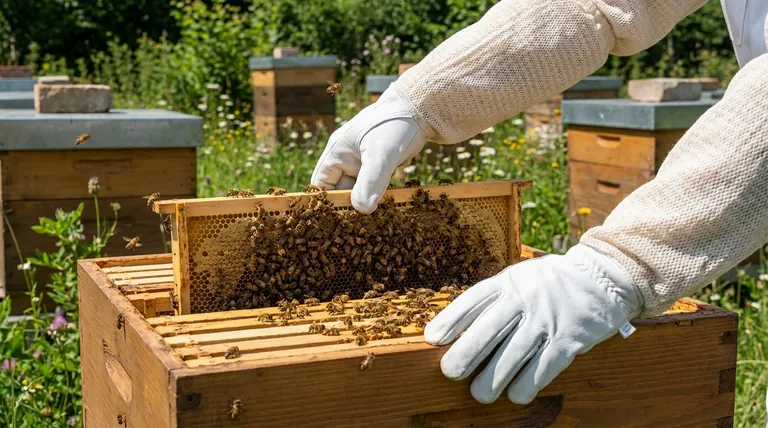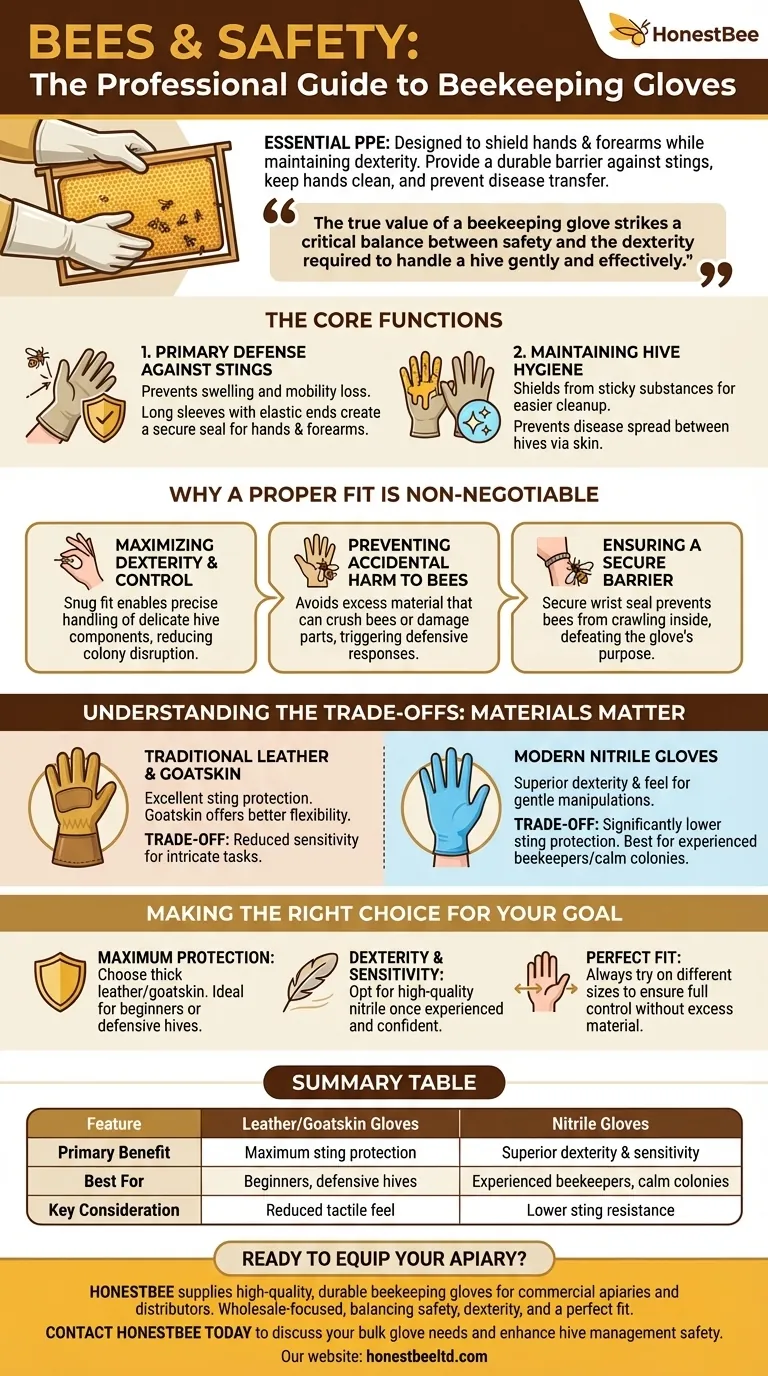Beekeeping gloves are essential personal protective equipment designed to shield a beekeeper's hands and forearms from stings while working with hives. Typically made from materials like leather, goatskin, or nitrile, their primary function is to provide a durable barrier against bees, while also keeping hands clean from sticky honey and preventing the transfer of bee diseases.
The true value of a beekeeping glove isn't just in sting protection, but in the critical balance it strikes between safety and the dexterity required to handle a hive gently and effectively.

The Core Functions of Beekeeping Gloves
Beekeeping gloves serve as more than just a barrier. They are a tool that enables safer, cleaner, and more confident beekeeping.
Primary Defense Against Stings
The most obvious purpose is protection. Bee stings on the hands can cause significant swelling, which severely reduces mobility and the fine motor skills needed for delicate hive inspections.
Most gloves feature long sleeves that extend towards the elbow, with an elastic end to create a secure seal. This design ensures that both the hands and forearms are fully covered, preventing bees from crawling inside.
Maintaining Hive Hygiene
Gloves protect your hands from becoming coated in sticky honey, wax, and propolis. This makes cleanup easier and, more importantly, helps prevent the potential spread of diseases from one hive to another on the beekeeper's skin.
Why a Proper Fit is Non-Negotiable
The effectiveness of a beekeeping glove is almost entirely dependent on its fit. An improperly sized glove can create more problems than it solves.
Maximizing Dexterity and Control
A snug, well-fitting glove allows you to handle delicate hive components, such as frames, with precision. This control is essential for performing inspections without causing unnecessary disruption or stress to the colony.
Preventing Accidental Harm to Bees
Loose-fitting gloves with excess material can be clumsy. This increases the risk of accidentally crushing bees or damaging fragile parts of the hive, which can trigger a defensive response from the colony.
Ensuring a Secure Barrier
A proper fit ensures the glove is secure at the wrist. This prevents bees from finding a gap and crawling inside, which would defeat the glove's primary purpose and likely result in stings.
Understanding the Trade-offs: Materials Matter
Different materials offer a different balance between protection and sensitivity. The right choice often depends on the beekeeper's experience level and the temperament of their bees.
Traditional Leather and Goatskin
These are the most common materials, offering excellent protection against stings due to their thickness. Goatskin is often preferred as it is slightly more flexible than standard leather, offering better dexterity.
The primary trade-off is a reduction in sensitivity. It can be harder to feel what you are doing, which may be a challenge for intricate tasks.
Modern Nitrile Gloves
Many experienced beekeepers are opting for thick, disposable nitrile exam gloves. These offer superior dexterity and feel, allowing for very gentle and precise hive manipulations.
However, their sting protection is significantly lower than leather. They are best suited for those working with calm colonies or who have the experience to handle bees with minimal disturbance.
Making the Right Choice for Your Goal
Selecting the right glove is a personal decision based on your comfort level and the needs of your apiary.
- If your primary focus is maximum protection: Choose a thick, well-fitting leather or goatskin glove, especially if you are a beginner or working with a more defensive hive.
- If your primary focus is dexterity and hive sensitivity: Consider using high-quality nitrile gloves once you are comfortable and confident in your ability to work calmly.
- If your primary focus is a perfect fit: Always try on different sizes and materials before purchasing to ensure you have full control and comfort without excess material.
Ultimately, the best beekeeping glove is the one that gives you the confidence to work calmly and effectively.
Summary Table:
| Feature | Leather/Goatskin Gloves | Nitrile Gloves |
|---|---|---|
| Primary Benefit | Maximum sting protection | Superior dexterity and sensitivity |
| Best For | Beginners, defensive hives | Experienced beekeepers, calm colonies |
| Key Consideration | Reduced tactile feel | Lower sting resistance |
Ready to equip your apiary with the right protection?
HONESTBEE supplies commercial apiaries and beekeeping equipment distributors with high-quality, durable beekeeping gloves designed for professional use. Our wholesale-focused operations ensure you get the best value on essential PPE that balances safety, dexterity, and a perfect fit.
Contact HONESTBEE today to discuss your bulk glove needs and enhance your hive management safety.
Visual Guide

Related Products
- Mesh Ventilated 3 Layer Goatskin Beekeepers Gloves for Beekeeping
- Goatskin Leather Beekeeper Gloves with Vent Long Sleeve for Beekeeping Honey Bee Sting Proof Protection
- Professional Drop-Style Hive Handles for Beekeeping
- Goat Skin Leather Bee Sting Proof Beekeeping Gloves with Canvas Sleeve
- HONESTBEE Professional Long Handled Hive Tool with Precision Cutting Blade
People Also Ask
- Why do some beekeepers choose not to wear protective gear? Experience vs. Dexterity in Hive Management
- What is the recommendation for beginning beekeepers regarding gloves? Build Confidence and Safety
- What factors should be considered when selecting beekeeping gloves? Balance Protection and Dexterity
- Do beekeeping gloves completely prevent stings? Maximize Your Hive Safety and Confidence
- What are the key considerations for the fit of beekeeping gloves? Ensure Dexterity & Safety



















